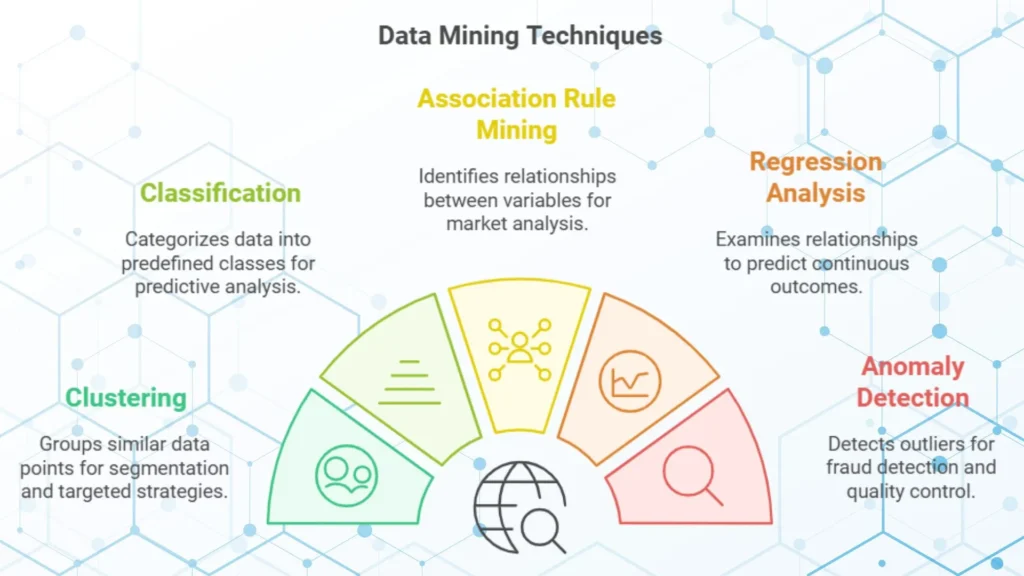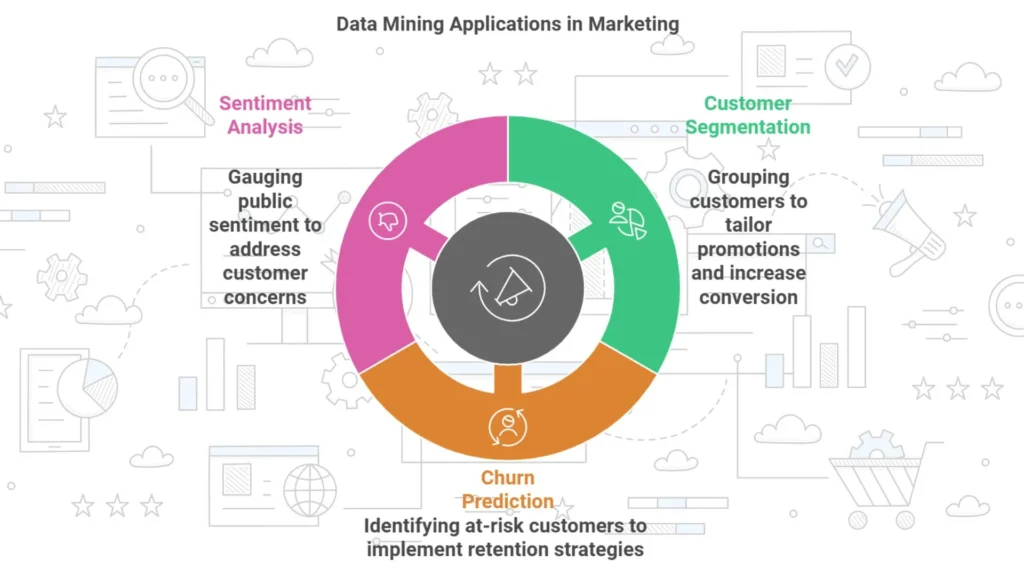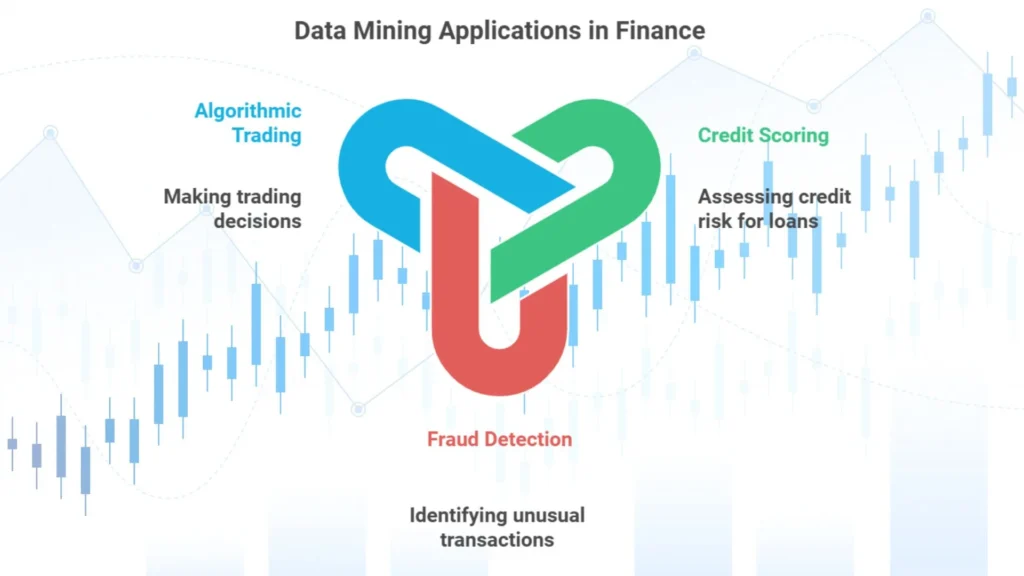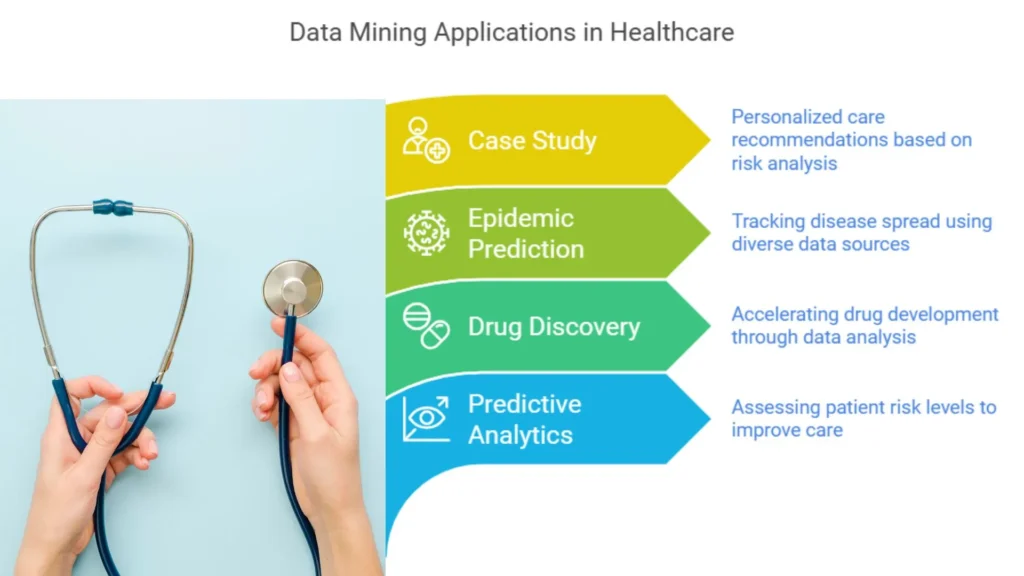Now a days businesses have access to large amounts of data. However, data in its raw form is generally very hard to interpret. This is where data mining comes in picture. But, what is data mining? Data mining a powerful technique that helps organizations to reveal patterns, trends and information hidden within large datasets.
By using data analytics and transforming raw data into valuable knowledge, data mining helps us to make smarter decisions, better customer understanding and increased operational efficiency.
In this guide, we shall explore the fundamentals of data mining, the techniques involved and practical applications across various industries, including marketing, finance and healthcare.
What is Data Mining?
Data mining is the process of exploring and analyzing large datasets to find meaningful patterns and relationships. It uses a combination of statistical analysis, machine learning and database management to identify trends that are not obvious. By knowing these hidden data, data mining enables businesses to make data driven decisions and predict future trends.
Data mining is an essential part of Knowledge Discovery in Databases (KDD), which involves several steps:
1. Data Cleaning: Removing or correcting errors in data.
2. Data Integration: Combining data from multiple sources.
3. Data Selection: Selecting relevant data for analysis.
4. Data Transformation: Converting data into a suitable format.
5. Data Mining: Applying algorithms to extract patterns.
6. Pattern Evaluation: Assessing the usefulness of discovered patterns.
7. Knowledge Representation: Presenting the findings in a clear format, often through visualizations.

Benefits of Data Mining
Data mining offers following advantages to businesses:
Discover Customer Preferences:
Understand customer behaviors and preferences to match suitable products and marketing efforts to improve customer satisfaction and loyalty.
Predict Trends:
Anticipate changes in the market or customer demand.
Improve Decision Making:
Data mining provides actionable tips, which helps businesses to make informed decisions.
Optimize Operations:
Streamline processes and reduce costs by identifying operational inefficiencies and improve productivity.
For instance, Walmart uses data mining to analyze customer purchasing patterns, which helps them to manage inventory and optimize stock levels. By mining their sales data, Walmart discovered that sales of certain items, like Pop-Tarts, spike before a storm, which allows them to stock up in advance.
Key Data Mining Techniques
Data mining consists of various techniques, each suited to different types of data and analysis goals. Here are some of the most commonly used data mining techniques:

1. Clustering
Clustering groups similar data points together, which makes it easier to identify segments within a dataset. This technique is commonly used for customer segmentation, which allows companies to target specific groups with matched marketing strategies.
Example: An e-commerce company could use clustering to segment customers based on purchasing behavior. High spending customers might receive exclusive offers, while occasional shoppers get targeted incentives to increase engagement.
2. Classification
Classification is used to categorize data into predefined classes. This technique is especially useful for predictive analysis, as it can classify new data points based on patterns learned from historical data.
Example: A bank could use classification to predict loan default risk. By analyzing historical data, they can classify new applicants as high or low risk, which allows them to make more informed lending decisions.
3. Association Rule Mining
Association rule mining identifies relationships between variables in a dataset. This is often used to find products frequently purchased together. It is best known for applications in market basket analysis.
Example: Amazon uses association rule mining to suggest related products based on previous purchases. If customers who bought a smartphone often buy a protective case, Amazon may recommend cases to new smartphone buyers, which increases the chances of a sale.
4. Regression Analysis
Regression analysis examines relationships between dependent and independent variables, which allows companies to predict continuous outcomes. It is often used to forecast sales, pricing and financial metrics.
Example: Real estate firms use regression analysis to predict property prices based on variables like location, square footage and amenities.
5. Anomaly Detection
Anomaly detection identifies outliers or unusual data points within a dataset. This technique is particularly valuable in fraud detection, quality control and cybersecurity.
Example: Credit card companies use anomaly detection to detect unusual spending patterns. If a customer’s account shows suspicious activity, like a high value purchase in a foreign country, it may trigger an alert for possible fraud.
Real World Applications of Data Mining
Data mining has changed multiple industries by enabling data driven information. Here’s how it is applied in marketing, finance and healthcare:

1. Data Mining in Marketing
Marketing teams rely heavily on data mining to understand customer behavior and optimize campaigns. Here are some ways it is used:
Customer Segmentation:
Marketers use clustering to group customers based on demographics, interests or purchasing habits. This helps them to match promotions to each segment, which increases the likelihood of conversion.
Churn Prediction:
Classification models identify customers at risk of leaving, which allows businesses to implement retention strategies.
Sentiment Analysis:
By analyzing social media and review data, companies can check public sentiment about their brand or products, which helps them tackle customer concerns in real time.
Case Study: Amazon is a well known example of data mining in marketing. Through extensive data analysis, Amazon recommends products to users based on past purchases, browsing history, and items frequently bought together. This level of personalization has been key to Amazon’s success.
2. Data Mining in Finance
In finance, data mining is used to manage risk, detect fraud and make informed investment decisions.

Credit Scoring:
Banks and credit agencies use classification to assess credit risk, which determines who qualifies for loans and at what interest rates.
Fraud Detection:
Anomaly detection helps identify unusual transactions, such as a sudden large withdrawal or an out of pattern purchase, which may indicate fraud.
Algorithmic Trading:
Data mining techniques, particularly predictive analytics, are used in stock market trading algorithms to make buy and sell decisions based on historical price patterns.
Case Study: JPMorgan Chase uses data mining to detect fraud in real time, which pin points transactions that don’t fit a customer’s usual behavior. This allows the bank to reduce fraudulent losses and improve customer trust.
3. Data Mining in Healthcare
In healthcare, data mining provides insights into patient care, disease prevention, and operational efficiency.

Predictive Analytics for Patient Outcomes:
Hospitals use predictive models to assess patient risk levels, which helps to allocate resources to high risk patients and improve care.
Drug Discovery and Development:
Data mining accelerates the drug discovery process by analyzing biological data and predicting drug efficacy.
Epidemic Outbreak Prediction:
By analyzing healthcare records and social media data, health organizations can track disease spread and take preventative action.
Case Study: Health insurance companies use data mining to predict patients’ future health risks, which enables them to make personalized care recommendations. For example, by analyzing lifestyle and medical history data, insurers can identify individuals at higher risk of chronic diseases, so as to provide preventive resources and reduce healthcare costs.
Challenges and Ethical Considerations in Data Mining
Despite its benefits, data mining also presents challenges:
1. Data Privacy:
Mining large amount of sensitive data can raise privacy concerns, especially if companies do not protect customer information properly.
2. Data Quality:
Poor quality data can lead to inaccurate information. Data cleaning and validation are essential for effective data mining.
3. Complexity:
Implementing data mining techniques requires technical expertise and advanced tools. Complex algorithms can produce results that are difficult to interpret, which makes it hard for decision makers to act on the findings.
Ethical Considerations
Ethical issues in data mining revolve around privacy, consent and transparency. Businesses must ensure they handle data responsibly and comply with data privacy regulations like GDPR. Transparent data practices develop trust and demonstrate a commitment to protect customer information.
Example: In the Cambridge Analytica scandal, personal data from millions of Facebook users was mined and used without consent, which lead to widespread backlash and a global conversation about data ethics.
Future Trends in Data Mining
As technology advances, data mining will continue to evolve, with several trends shaping its future:
AI and Machine Learning:
AI driven data mining techniques will make analysis faster, more accurate and available to more businesses.
Real Time Data Mining:
With the rise of IoT, companies will be able to mine data in real time, which allows them for quicker information and faster decision making.
Enhanced Data Privacy:
New regulations and privacy preserving technologies, such as differential privacy, will enable safer data mining practices without compromising personal information.
Key Takeaways
– Data mining helps organizations to discover patterns and information from large datasets, which supports data driven decision making.
– Techniques like clustering, classification, association rule mining, regression and anomaly detection are essential tools for analyzing data.
– Data mining has applications across industries, from personalized marketing to fraud detection in finance and predictive healthcare.
– Challenges include data privacy concerns, data quality issues and complexity, which emphasizes the importance of ethical data practices.
Conclusion:
Data mining transforms raw data into actionable information, which helps businesses to discover hidden potential. As we move forward, advancements in technology will continue to enhance data mining’s capabilities. This will make it even more valuable asset for organizations across the globe.
Data mining serves as a starting point for businesses to use their data for greater information and competitive advantage. With the right approach and tools, data mining can discover the hidden gems in your data, that helps to make smarter strategies and take more informed decisions.

